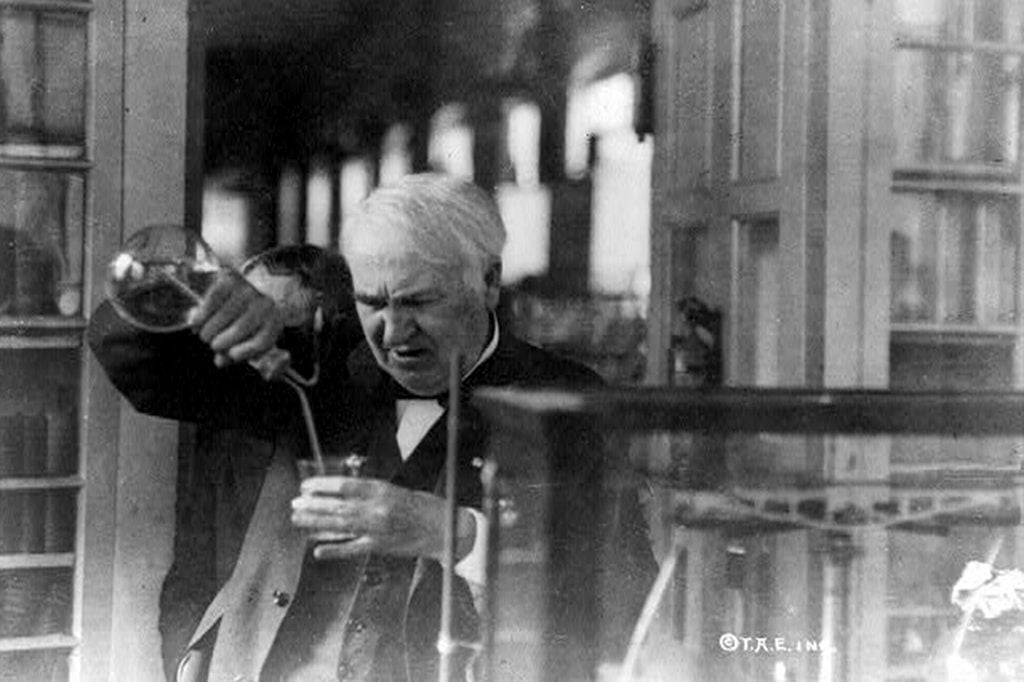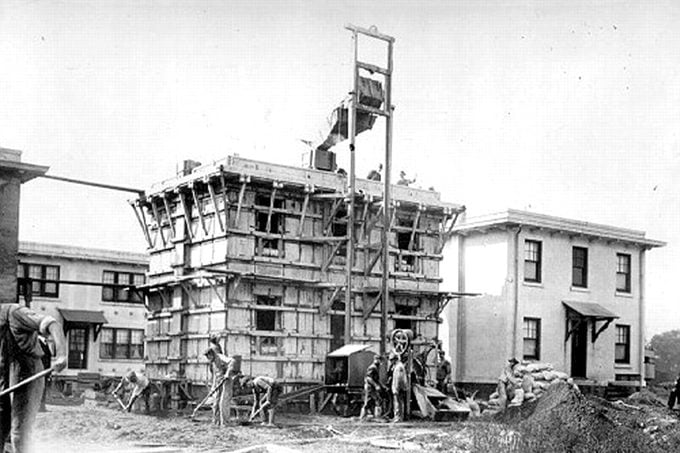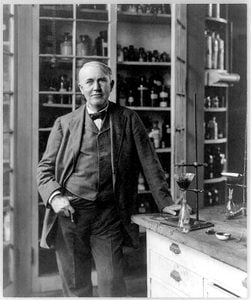6 Thomas Edison Inventions You Didn’t Know About
Updated: Mar. 14, 2023

For every phonograph, there was a concrete bathtub.
Forget the light bulb. Thomas Edison’s greatest invention was a two-story house in rural New Jersey. In March 1876, Edison set up his famous Menlo Park laboratory—the world’s first research and development facility, where dozens of chemists, engineers, and draftsmen gathered to develop more than 400 patented inventions, including the phonograph and electric lighting. Edison, of course, claimed them all as his own, racking up a staggering 1,093 patents in his name in the United States alone. But they weren’t all winners: For every light bulb, there was a concrete piano, too. Below are six unusual Thomas Edison inventions you might not be aware of the “Wizard of Menlo Park” actually conjured up.
1. Saying “Hello”
Chalk it up to excitement or just plain rudeness, but Alexander Graham Bell’s notorious first words on the telephone in 1877—“Mr. Watson, come here. I want to see you.”—came without a greeting.
Now that the phone was invented, it was time to invent phone etiquette, beginning with the crucial question: What should someone say when answering this new-fangled talky machine? Graham Bell first proposed “Ahoy, ahoy,” calling to mind a classic sailor’s salutation. Others opted for no greeting at all, as the earliest telephones were just permanently open lines between two parties; a clanging call bell sufficed over any spoken phrase. But Thomas Edison, ever one to dance to the tune of his own phonograph, had his own thoughts. When setting up a new office with its first phone system, Edison proposed this to a colleague: “Friend David, I don’t think we shall need a call bell as Hello! can be heard 10 to 20 feet away. What do you think?”
Whatever Friend David thought, “hello” caught on. By 1881 Edison’s phrase entered the dictionary, and telephone exchange operators across the country soon became known as “hello-girls.”

2. The Ultimate Cookie-Cutter House
Like this one, some Thomas Edison inventions are so bizarre, you’ve never heard of them at all, let alone attributed them to Edison. When a failed ore-milling venture left Edison with a lot of sand byproducts on his hands, he decided to put it to use in the cement business. So, he made one: The Edison Portland Cement Company, founded in 1899. Though the company would one day put its stamp on New York through the original Yankee Stadium (1922-2008), its early days were marred by failure—mostly due to Edison’s misguided scheme to make concrete chic. By investing in a single giant cast-concrete house mold “including the sides, roofs, partitions, bathtubs, floors, etc.,” Edison proposed that qualified builders could literally pour cheap, durable homes in a few hours apiece. Patent in hand, he curried the support of donors eager to solve New York’s housing crisis. Edison boldly called his project “the salvation of the slum dweller.”
While ingenious in theory, Edison’s plan had two problems: builders would have to invest an exorbitant $175,000 in a single house mold before construction could start, and few homeowners wanted to live in a concrete box for “slum dwellers.” His housing idea sunk like a pair of concrete loafers, a desperate Edison pivoted to building molds for cast-concrete beds, phonograph cabinets, and pianos. Only a few Edison Portland Cement Company houses were ever cast. They remain grudgingly inhabited in Union, New Jersey, “a monument to one of the most colossal flops in the history of scientific innovation.” Edison may have regretted the cookie-cutter houses, but maybe not as much as these inventors who regretted their inventions.
3. Talking Nightmare Dolls
In 1877, Edison’s phonograph became the first device capable of both recording and reproducing sound; by 1890, he found the creepiest possible way to implement it. The concept was simple: take a phonograph player equipped with a short recorded nursery rhyme, and shrink it to fit inside a 22-inch baby doll’s chest. Decades ahead of Chatty Cathy, Edison’s crank-powered companions could recite “Jack and Jill,” “Twinkle, Twinkle Little Star,” or “Now I Lay Me Down To Sleep” on command. It was a revolutionary idea… executed disastrously.
Wax phonograph cylinders, it turned out, did not keep well when shrunken down and thrust into the hands of eager children; most recordings warped or scratched to the point of horrific gibberish after a few uses. The relatively complex technology also drove the price of the doll up to between $10 (naked) and $20 (dress included), which in 1890 translates ridiculously to about two weeks’ salary. Only some 500 dolls were sold, and many returned by unhappy customers before Edison Talking Dolls were discontinued barely a month into their production. If you think that’s harsh, just listen to what they sounded like. After hearing these recordings, you may be glad you’ve never owned one of these Thomas Edison inventions. Get to know about the weirdest inventions ever.
4. Vacuum-Sealed Fruit
If necessity is the mother of invention, someone at Edison labs must have really wanted a banana. While working on the light bulb that would seal their boss’s legacy in the late 1870s, Edison’s inventors had a lot of vacuum pumps on hand for exhausting air from incandescent globes. Someone had the bright idea of using these same vacuum pumps to seal fruit in an air-tight glass dome of flavor, one of the great Thomas Edison inventions helping the creation of another.
In 1881, Edison patented a “method of preserving fruit,” which basically amounted to an early method of vacuum-sealed packaging. The fruits, vegetables, “or other organic substances” were placed in a glass container, hand-pumped clear of air then capped and stored for preservation. Today, machines do the pumping for us, but the science behind Edison’s preservation method continues to bear fruit. Incidentally, Thomas Edison’s last breath, exhaled on October 18, 1931, remains similarly preserved in a tube at the Henry Ford museum.

5. The Hollywood Film Industry
Apparently never satisfied with his accomplishments, Edison wrote in 1888, “I am experimenting upon an instrument which does for the Eye what the phonograph does for the Ear.” Within a few years he held patents for one of the earliest motion picture cameras, built America’s first movie studio (installed on a rotating platform to track the sun across his West Orange, New Jersey property), purchased the rights for a primitive film projector called the “Vitascope,” and released Fred Ott’s Sneeze, the first motion picture to be copyrighted in the United States. By 1896, Edison was selling tickets to public screenings across the country—great times for him, bad for everyone else. While other people were experimenting with film and motion picture around the same time or even earlier, due to his perseverance and consistent patenting, this one will definitely go down in history as one of the best Thomas Edison inventions.
In those pre-trust-busting days, it was perfectly cool for one person to hold all the patents for the production, distribution, and exhibition of motion pictures. So in 1908, Edison embraced his monopoly by forming the Motion Picture Patent Company (aka “The Edison Trust”). Both a high-output film studio and borderline movie mafia, Edison’s MPPC muscled competing studios into its ranks by refusing to sell Eastman Kodak film to non-trust members and dispatched “enforcers” to uphold his copyrights outside of court. Filmmakers who wanted to remain independent fled in droves to California, taking to the long, sunny days and lax patent courts. Blissfully removed from the MPPC patent police, Hollywood soon became the world capital of film—and remains so to this day. Original patents to products we use today are always interesting, according to the original patent, this is how you should hang your toilet paper.
6. Sexting?
It may be a stretch to call this “sexting” one of the Thomas Edison inventions, but the story goes that Edison taught Mina Miller, his second fiancee, how to communicate in Morse Code so they could tap private messages to each other while in the presence of her parents. What would a man want to say secretly to a woman without her parents hearing? The mind boggles.
One thing we do know is that Edison claims he proposed marriage to Mina in Code. Lucky for him, she responded, “ -.— . … ” You may not have known these things were invented by Thomas Edison, but you’ll be even more shocked by these inventions you never knew were created by women.